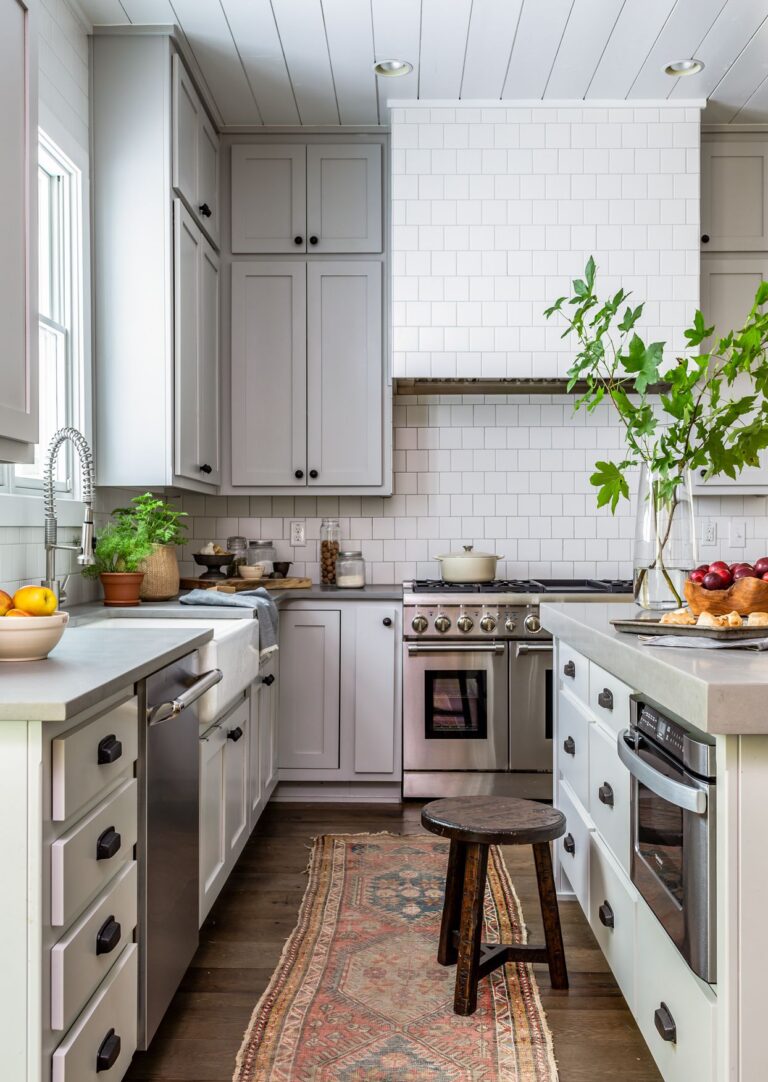A blend of contemporary and traditional styles, transitional kitchens are bright, relaxing and often include storage space. It's no wonder, then, that a recent survey by the National Kitchen & Bath Association (NKBA) identified these as the most popular style (and predicted to continue to be so for years to come).
“Transitional-style kitchens express an airy, casual elegance that's inviting,” says Loretta Willis, an Atlanta-based interior designer. “Its clean architectural lines and often neutral finishes speak to a timeless, classic style that incorporates the best of traditional and contemporary design.” Another popular choice. What are the reasons? The versatile style of transition kitchens is especially effective in homes with open layouts, as they take in from and into surrounding rooms.
Key transitional elements in the kitchen
simple color palette
The basics of transitional kitchen design are a simple color palette and a consistent design that eliminates visual distractions such as patterns and clutter. According to NKBA, white transitional kitchens are the most popular, followed by neutral colors like gray and beige. Wood style is also standard. Looking for something a little more vibrant? Blue is the most common non-neutral in transitional kitchens and one of the most popular colors in home design.
Clean lined cabinet
Transition kitchens rely heavily on storage to create a clutter-free space, so much of their visual impact comes from the cabinets. Most transitional kitchen cabinets are painted wood or wood grain cabinets, and their distinctive look comes from the clean lines of recessed panel doors, similar to Shaker cabinets.
sophisticated countertops
When it comes to countertops, transitional designs derive much of their streamlined look from low-maintenance quartz or quartzite countertops with sleek, unadorned edges. Thick countertop profiles and waterfall countertops over islands are also commonly used.
Panel or stainless steel appliances
Because of their simple surfaces and colors, appliances have more visual impact than you might expect in a transitional kitchen. For consistency, the NKBA says that appliances are usually all stainless steel, but adding panels to appliances to match the cabinetry can further enhance the appearance. Range hoods are often built-in or covered so that they blend in rather than stand out.
Willis suggests making the most of the simple aesthetics of Transitional style with “great lighting, innovative, energy-efficient appliances, and floor plans that contribute to and support the homeowner's lifestyle.” I am. Use the following transitional kitchens and elements as inspiration for your own renovation.
interim kitchen lighting
Pendant lighting is the most notable decorative element in transitional kitchens. We're seeing a lot of more modern industrial pendants and oversized pendants, but the kitchen above proves there's a place for traditional pendants too. The dark, slim lines of the open shelf mimic the delicate cage of a classic lantern pendant above the island. So neither item feels out of place, with the curves of the light fixtures echoing the kitchen's elegant faucets and the crisp lines of the shelves echoing the island seating.
Timeless transitional kitchen accents
herringbone pattern
Herringbone is a classic pattern perfect for a transitional kitchen backsplash, and these long ceramic tiles give it a modern feel. Simple wood trim dramatically frames the window above the sink, mimicking Shaker-style cabinet doors without detracting from the wall pattern.
geometric design
Geometric tiles are a contemporary idea that mimics the overall crisp lines of transitional styles. When used in small amounts, dark grout lines can be interesting without being too messy. However, if you use geometric tiles in a larger surface area or in a small kitchen, choose a grout color that is close to the tile to minimize patterns.
plank flooring
Plank-style flooring, especially wood and wood grain flooring, is also common in transitional kitchens. Whether dark or bright, rich colors bring traditional warmth to your space. Wood floors complement the warm, rustic green cabinet color. Willis suggests looking to transitional kitchen flooring to add a little personal style. “Updating your floors by adding a great runner or a designer rug in a tonal color will improve the overall look of your kitchen space,” she says.
white transitional kitchen ideas
In this white transitional kitchen, the island, floor, and ceiling beams exude wood tones that contrast with the light cabinetry. Panelized home appliances are integrated into the cabinet, creating a clean surrounding. A colorful patterned backsplash is effective because it is confined to the stove area.
Create balance
Although the foundation of this space is not traditional, the extensive light fixtures give the look an edge. Deep blacks are balanced by dark cabinet hardware, windows, and wooden ceiling beams. A dramatically thick marble countertop ties the room together.
emphasize natural light
Transition kitchens typically feature neutral cabinetry to make the most of natural light. This space is taken a step further with reflective white ceramic tiles on the walls and range hood. Bringing the cabinets and wall decor all the way to the ceiling creates a clean kitchen outline.
Migration details
Other notable design features of transitional kitchens include apron-front sinks and abundant cabinet drawer storage. Dark trash can handles may seem like they can create visual clutter, but because they're tucked under the countertop or within the kitchen's work zone, they're more helpful than distracting.
Open concept transitional kitchen
Transitional styles are often seen in open kitchens because they allow you to easily incorporate features from other spaces.
glass front cabinet
In this space, glass cabinetry, unusual for a transitional kitchen, borrows the blue of the curtains in the adjacent room. Anchored within a mostly closed cabinet wall and with a simple mix of white, glass and chrome flatware, the cabinetry adds interest rather than looking too busy.
waterfall countertop
The contemporary waterfall countertop is an elegant feature often used in transitional kitchens. In an open space, a waterfall countertop streamlines the look of the island, hiding the chair legs and part of the island's base to reduce visual clutter.


